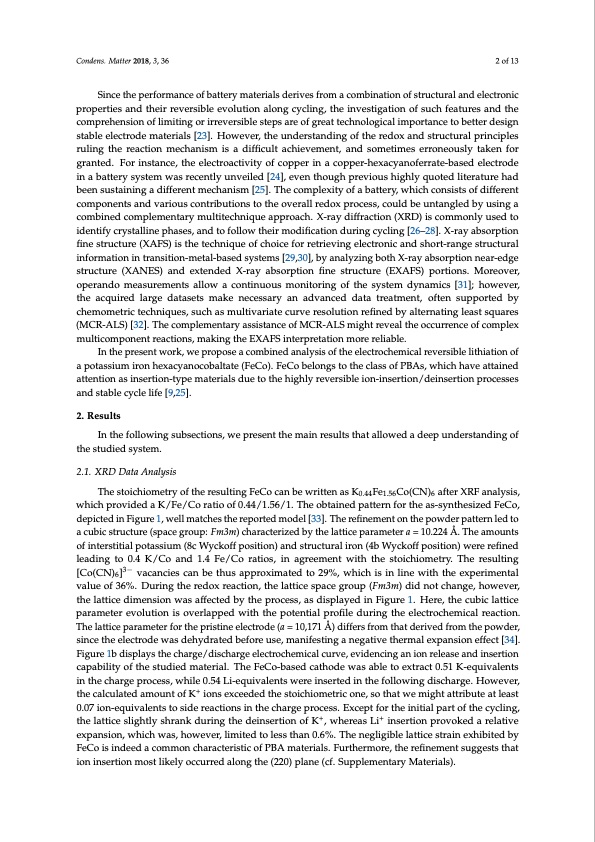
PDF Publication Title:
Text from PDF Page: 002
Condens. Matter 2018, 3, 36 2 of 13 Since the performance of battery materials derives from a combination of structural and electronic properties and their reversible evolution along cycling, the investigation of such features and the comprehension of limiting or irreversible steps are of great technological importance to better design stable electrode materials [23]. However, the understanding of the redox and structural principles ruling the reaction mechanism is a difficult achievement, and sometimes erroneously taken for granted. For instance, the electroactivity of copper in a copper-hexacyanoferrate-based electrode in a battery system was recently unveiled [24], even though previous highly quoted literature had been sustaining a different mechanism [25]. The complexity of a battery, which consists of different components and various contributions to the overall redox process, could be untangled by using a combined complementary multitechnique approach. X-ray diffraction (XRD) is commonly used to identify crystalline phases, and to follow their modification during cycling [26–28]. X-ray absorption fine structure (XAFS) is the technique of choice for retrieving electronic and short-range structural information in transition-metal-based systems [29,30], by analyzing both X-ray absorption near-edge structure (XANES) and extended X-ray absorption fine structure (EXAFS) portions. Moreover, operando measurements allow a continuous monitoring of the system dynamics [31]; however, the acquired large datasets make necessary an advanced data treatment, often supported by chemometric techniques, such as multivariate curve resolution refined by alternating least squares (MCR-ALS) [32]. The complementary assistance of MCR-ALS might reveal the occurrence of complex multicomponent reactions, making the EXAFS interpretation more reliable. In the present work, we propose a combined analysis of the electrochemical reversible lithiation of a potassium iron hexacyanocobaltate (FeCo). FeCo belongs to the class of PBAs, which have attained attention as insertion-type materials due to the highly reversible ion-insertion/deinsertion processes and stable cycle life [9,25]. 2. Results In the following subsections, we present the main results that allowed a deep understanding of the studied system. 2.1. XRD Data Analysis The stoichiometry of the resulting FeCo can be written as K0.44Fe1.56Co(CN)6 after XRF analysis, which provided a K/Fe/Co ratio of 0.44/1.56/1. The obtained pattern for the as-synthesized FeCo, depicted in Figure 1, well matches the reported model [33]. The refinement on the powder pattern led to a cubic structure (space group: Fm3m) characterized by the lattice parameter a = 10.224 Å. The amounts of interstitial potassium (8c Wyckoff position) and structural iron (4b Wyckoff position) were refined leading to 0.4 K/Co and 1.4 Fe/Co ratios, in agreement with the stoichiometry. The resulting [Co(CN)6]3− vacancies can be thus approximated to 29%, which is in line with the experimental value of 36%. During the redox reaction, the lattice space group (Fm3m) did not change, however, the lattice dimension was affected by the process, as displayed in Figure 1. Here, the cubic lattice parameter evolution is overlapped with the potential profile during the electrochemical reaction. The lattice parameter for the pristine electrode (a = 10,171 Å) differs from that derived from the powder, since the electrode was dehydrated before use, manifesting a negative thermal expansion effect [34]. Figure 1b displays the charge/discharge electrochemical curve, evidencing an ion release and insertion capability of the studied material. The FeCo-based cathode was able to extract 0.51 K-equivalents in the charge process, while 0.54 Li-equivalents were inserted in the following discharge. However, the calculated amount of K+ ions exceeded the stoichiometric one, so that we might attribute at least 0.07 ion-equivalents to side reactions in the charge process. Except for the initial part of the cycling, the lattice slightly shrank during the deinsertion of K+, whereas Li+ insertion provoked a relative expansion, which was, however, limited to less than 0.6%. The negligible lattice strain exhibited by FeCo is indeed a common characteristic of PBA materials. Furthermore, the refinement suggests that ion insertion most likely occurred along the (220) plane (cf. Supplementary Materials).PDF Image | XAFS and XRD Study of a Prussian Blue Analogue Cathode Iron Hexacyanocobaltate

PDF Search Title:
XAFS and XRD Study of a Prussian Blue Analogue Cathode Iron HexacyanocobaltateOriginal File Name Searched:
condensedmatter-03-00036.pdfDIY PDF Search: Google It | Yahoo | Bing
Sulfur Deposition on Carbon Nanofibers using Supercritical CO2 Sulfur Deposition on Carbon Nanofibers using Supercritical CO2. Gamma sulfur also known as mother of pearl sulfur and nacreous sulfur... More Info
CO2 Organic Rankine Cycle Experimenter Platform The supercritical CO2 phase change system is both a heat pump and organic rankine cycle which can be used for those purposes and as a supercritical extractor for advanced subcritical and supercritical extraction technology. Uses include producing nanoparticles, precious metal CO2 extraction, lithium battery recycling, and other applications... More Info
| CONTACT TEL: 608-238-6001 Email: greg@infinityturbine.com | RSS | AMP |